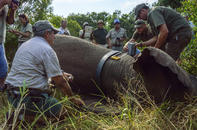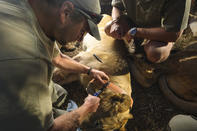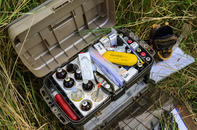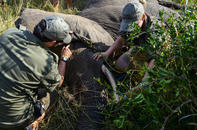Conservation the Scientific Way
After James Steven Hamilton retired in 1946, the scientists broke into the mainstream. Dr R Bigalke of the National Zoological Gardens in Pretoria was appointed to the board and he established a scientific division with a full-time zoologist.

He also championed several other worthy programmes in the park: the removal of alien plant species, an ambitious education programme, the establishment of a scientific journal and a historical survey of the region. Dozens of researchers thus invaded the wilderness every year, armed with clipboards and calculators.
They darted animals, fitted radio collars, filmed from helicopters. Gradually, they decoded the manifold mysteries of the natural world, and delighted the world with their discoveries. By 1957, the Board’s motto had become ‘management by intervention’. By 1965, the University of Pretoria was offering a degree in wildlife management.
A More Organic Approach

But, as the body of environmental knowledge grew, so did the researchers’ boldness. Some began to think that they knew better than nature and developed methods which, they felt, would stimulate biodiversity. Over-populated species were culled, artificial watering holes were dug, and the park was divided into 400 blocks for rotational burning.
Unfortunately, scientists don’t always get it right first time and some of these interventions are now considered overly invasive. The debate on the best way to handle conservation areas continues to this day. Should nature be left alone to establish its own balance, or should a threatened environment be actively managed to help it recover? The Kruger National Park has tried it both ways, and is now leaning towards a more organic approach that allows nature to take its course whenever possible.
'Holism and Evolution'

This change of direction is quite recent and can be traced back to the transformation of the old National Parks Board into the more inclusive South African National Parks (SANParks) organisation, which followed SA’s first democratic elections of 1994. After all, many members of the old Parks Board came from an agricultural background and wanted to run things the way they did on the farm.
This involved active management of natural resources and suggestions to the contrary were usually ignored. The new SANParks authorities, however, have a broader background and have sought input from various stakeholders. This has resulted in more holistic conservation strategies.
Incidentally, the concept of ‘holism’ was first coined by that old fan of conservation, Jan Smuts, back in 1926 when he published a book called ‘Holism and Evolution’. According to Smuts, the concept can be defined as “the tendency in nature to form wholes that are greater than the sum of the parts through creative evolution.”
Policies and Restrictions

As such, the park is now divided into a number of usage zones, each with its own policies and restrictions. These range from well-developed tourist nodes to pristine ‘wilderness’ areas where visitors are not allowed. The old controlled-burning policy has been replaced with a less intrusive mosaic or patch burning technique. Culling has largely been curtailed.
Even the extensive network of windmills is being revised, and several superfluous watering holes are being decommissioned. Furthermore, the Kruger National Park currently has over 150 active research projects involving scientists from all over the world. Everything from the biggest mammals to the smallest insects is studied, and a huge amount of invaluable information has been gathered within the great expanse of Kruger. There are also several ‘exclosures’ located around the park.
These are long-running experiments that are designed to investigate things like climate, rainfall and vegetation. You can see one of these exclosures on the S10, near Pretoriuskop.
By David Fleminger The Kruger National Park has a problem with elephants. There are simply too many of them. They are destructive eaters and impact heavily on ...
The Kruger National Park has a problem with elephants. There are simply too many of them. They are destructive eaters and impact heavily on ...